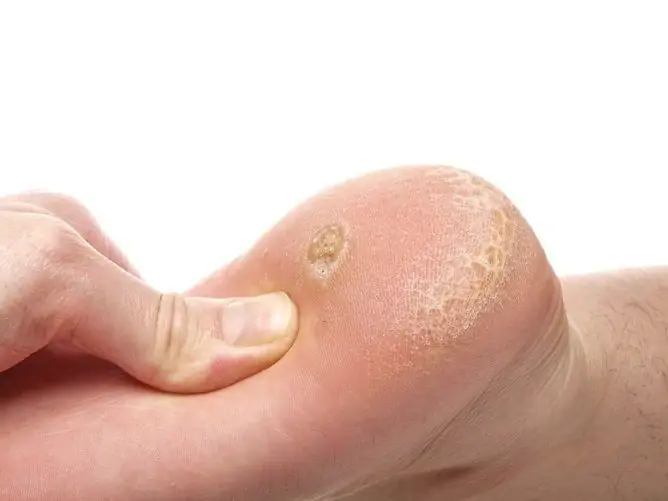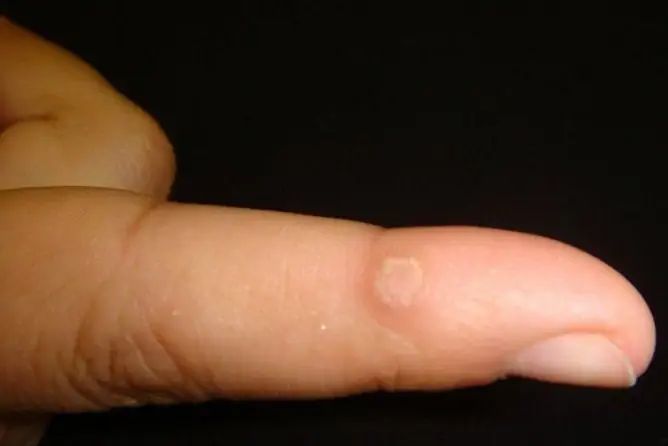- Author Rachel Wainwright [email protected].
- Public 2023-12-15 07:39.
- Last modified 2025-11-02 20:14.
Plantar wart in a child
The content of the article:
- The reasons
- Symptoms
-
Treatment
Traditional medicine methods
- Video
The plantar wart in a child belongs to benign proliferative skin pathologies and is of infectious origin. Features of the disease:
- More often, plantar warts occur in children over 10 years old, but the appearance is possible in other age periods.
- The main transmission route is contact-household (swimming pool, gym). Up to 80% of all cases are associated with microtrauma to the skin of the feet.
- There is no correlation relationship between boys and girls.
- Due to the peculiarities of the immune system in children over 10 years of age, the disease is predominantly asymptomatic (up to 50-60% of all cases). However, in children under 10 years of age, due to the imperfect immune response, the disease manifests itself with typical clinical signs.
- A long latent period of the disease is characteristic. The manifestation, as a rule, is associated with suppression of immunity (for example, after a viral or bacterial infection).
- Plantar formations are characterized by slow growth and a low risk of degeneration into malignant forms.

Plantar warts differ from others in soreness, so treatment is necessary
Children respond significantly better to therapy and are less likely to relapse than adults. When an education develops, a consultation with a dermatovenerologist and an oncologist is indicated (to exclude a number of benign and malignant formations with similar skin manifestations).
The reasons
The main etiological factor in the occurrence of warts is the human papillomavirus (HPV). Features of the pathogen:
- DNA-containing virus of the papavavirus family (Papavaviridae);
- affects the basal layer of the skin and causes cell proliferation in it;
- there are about 100 different genotypes, but the most relevant are alphapapillomavirus 2,16, 18, 27 57 (mainly affects the mucous membranes and has a high carcinogenic risk); beta papillomavirus and gammapapillomavirus 1, 2, 4 (mainly causes formations on the skin of the feet and palms).
Predisposing factors:
- Age features of the immune system. In children under 5 years of age, cellular and humoral immunity is imperfect, and for this reason there is not always an adequate response to the action of one or another pathogen. This group also includes HIV-exposed children (born to an HIV-infected mother and having a high risk of infection when passing through the birth canal).
- Viral and bacterial diseases (ARI, influenza). These pathologies do not lead to the direct occurrence of warts, but with their frequent occurrence (more than 5-7 times a year), the immune system is significantly weakened.
- Traumatic damage to the skin (abrasions, scratches). In this case, infection occurs through the damaged epidermis. This factor is realized only in conjunction with a weakened immune system.
- Infectious and non-infectious pathologies of the skin and mucous membranes. Various diseases create favorable conditions for trauma, which leads to a violation of the barrier and protective functions of the skin.
- Disorders in the work of the endocrine system (type I diabetes mellitus, hormonal changes in adolescence) leads to disruption of metabolic and metabolic processes throughout the body, including at the skin level. This leads to a violation of a number of functions of the skin, including the protective one.
- Improperly fitted footwear causes constant irritation and infection of the skin of the feet.
- Failure to comply with standard rules of personal and public hygiene.
Among other things, the impact of harmful environmental factors (for example, excessive insolation or hypothermia) matters.
Symptoms
In the photo, the appearance of a plantar wart has the following features:
- Dense, rounded formations that protrude above the surface of the surrounding skin and have clear boundaries. They can be either single or multiple. Rarely, the formations merge with the appearance of the so-called mosaic wart.
- The color of the lesion does not differ from the surrounding skin.
- The lesions are painful to palpation or pressure while walking. The pain does not occur immediately, but as the disease progresses and the volume of the affected area increases due to the involvement of nerve endings.
- The surface of the formation is uneven, granular, covered with hyperkeratotic layers. There is no skin pattern over this area.
- Sometimes in the center of the growth you can see a black-brown dot, which has arisen as a result of thrombosis of the capillaries of the superficial vascular network. Absent in the initial stages.
- Appear in places of maximum pressure (heel). May occur on the touching surfaces of the fingers ("kissing" warts).
Histological features of plantar warts:
- atypical proliferation of stratified squamous epithelium;
- hyper- and parakeratic layers on the cell surface;
- involvement of the deep layers of the dermis;
- eosinophilic cytoplasmic inclusions in cells.
Treatment
Treatment of a plantar wart in a child should start with conservative, and, if necessary, include surgical methods of exposure.
| Method | Description |
| Local chemical exposure |
The methods are based on the mummification of the formation and its gradual dying off with the formation of a wound, which is closed by primary intention in 2 weeks. It quickly cures almost any type of warts, but is not applicable to formations with a diameter of more than 5 cm. 1. The build-up is exposed to a 1.5% solution of zinc chloropropionate in 50% 2-chloropropionic acid. The procedure is carried out in compliance with all the rules of asepsis and antiseptics (the treatment of the affected area is carried out only in the treatment room). The solution is applied pointwise to the affected area. A slight change in the color of the wart to a grayish-white is an indicator of correct application. A clearer indicator is the infiltration zone, which occurs 5-10 minutes after several applications of the drug. To obtain the proper result, up to 3 treatments are required within 15-20 days. During the course of procedures, it is required to limit the load on the limb. It is not allowed to independently treat the affected area with antiseptic solutions. 2. The wart is treated with a combination of nitric, acetic, oxalic, lactic acids and copper nitrate trihydrate. After the procedure, control is shown in 3-5 days. It is possible to get rid of the build-up in 90% of cases without the risk of recurrence. |
| Local physical impact |
Allows you to remove warts in children of any age. 1. Electrocoagulation. Layer-by-layer point burning of the formation using an electric current. It is performed under local infiltration anesthesia with 2% lidocaine. 2. Cryodestruction. Impact on the center of ultra-low temperatures. It is carried out using liquid nitrogen or nitrous oxide. One of the substances with the help of special tools is applied to the hearth for 1-5 minutes. For the sole, several repeated courses of treatment after 5-7 days can be used due to the dense rough skin. 3. Laser destruction. It is required to remove the lesion on the foot in layers using a concentrated beam of light. The light guide is used in a continuous mode on the focus from 2-5 seconds to 2-3 minutes, depending on the size. After that, you need to clean the area with a gauze cloth dipped in an alcohol solution. During the healing period, it is recommended to treat the focus with antiseptic solutions until the scab is rejected and the wound is completely healed. It is performed under local anesthesia. 4. Radiosurgical destruction. The method is based on the effect of an electromagnetic wave on the affected area. In this case, there is an intense warming up of the build-up tissue and dissection without direct cauterization and coagulation. It is performed under local infiltration anesthesia with 2% lidocaine. |
| Exposure to topical drugs |
1. Ointment Viferon. Has an immunostimulating and anti-inflammatory effect. The action is aimed at inhibiting the replication of the virus in cells and stopping the intensive growth of the wart. Apply 3-4 times a day for 2-3 weeks. 2. Panavir. It is produced in the form of a gel, has an antiviral effect. Apply 2-3 times a day for 7-10 days. 3. Super cleaners. A drug containing potassium and sodium hydroxide has an effect similar to acids (cauterizes the focus). It is applied 1-2 times a day for 5 days. |
| Systemic exposure |
Therapy is aimed at strengthening the immune system and reducing the risk of relapse. Groups of medicines: Systemic and local retinoids (Isotretinoin); · Modulators of the immune response (Interferon, Isoprinosine). Representatives: Interferon. For plantar warts, the dose of the drug is from 1.5 to 3 million IU intramuscularly or subcutaneously for 4 weeks. Isoprinosine. Affects cellular immunity. It is prescribed 2 tablets 3 times a day in combination with local therapy. The course lasts 28 days on average. Gepon. It activates the work of macrophages and stimulates the production of cytokines, has a pronounced antiviral activity (inhibits the replication of the virus). It is used systemically in a dosage of 10 mg orally 1 time per day or 0.02-0.04% solution for local skin treatment 1 time per day. |

Laser destruction is one of the safest and most effective methods of removing plantar warts in children.
Treatment is required taking into account the area of the lesions. All drugs are prescribed for children only by a doctor, treatment is carried out under his control.
Traditional medicine methods
In addition to the main treatment in uncomplicated cases, it is allowed to resort to folk remedies to remove neoplasms. You can try to remove a plantar wart at home using the following means:
- Garlic. Grind 3-4 cloves until they become mushy. Apply on the affected area 2-3 times a day in the form of compresses for 15-20 minutes.
- Potatoes. Peel potatoes and finely grate. Squeeze the resulting mixture and juice the wart 5-6 times a day for 14 days.
- Celandine. Press on the stem of a freshly plucked plant until the juice is released. Treat the wart 4-6 times a day for 1 month.
- Calendula. Grind 2-3 flowers of the plant and fix to the wart for 1-2 hours. The course of treatment is 1-2 months.
- Bow. Finely chop one small onion, wrap it in cheesecloth and apply in the form of a compress for 10-20 minutes to the wart. The course of treatment is 10-20 days.
Also, various tinctures and decoctions of medicinal plants (chamomile, calendula, marshmallow, tarragon) are used inside, which help to strengthen the immune system.
Video
We offer for viewing a video on the topic of the article.

Elena Minkina Doctor anesthesiologist-resuscitator About the author
Education: graduated from the Tashkent State Medical Institute, specializing in general medicine in 1991. Repeatedly passed refresher courses.
Work experience: anesthesiologist-resuscitator of the city maternity complex, resuscitator of the hemodialysis department.
Found a mistake in the text? Select it and press Ctrl + Enter.






